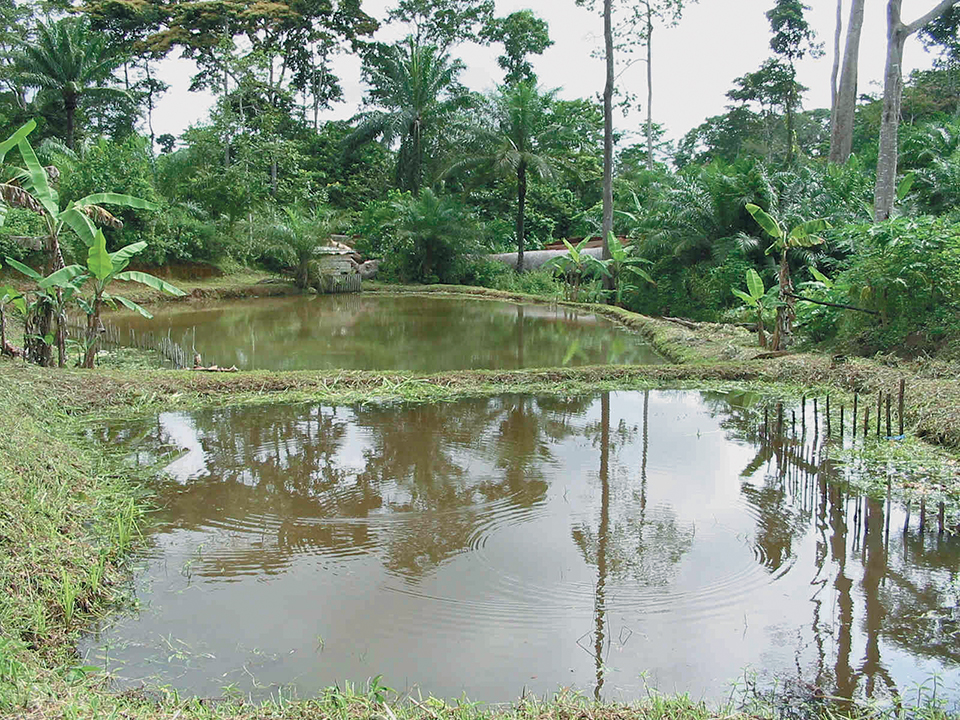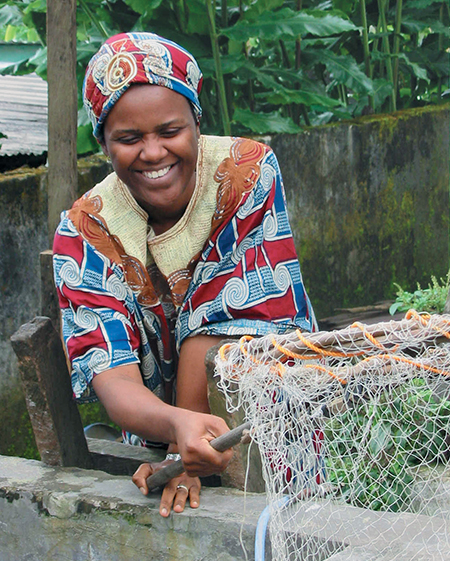New approach provides technical oversight through a small team of researchers and extension agents

Fish culture has a relatively long history in Cameroon. Beginning with experiments conducted in 1948 by the French colonial administration, its subsequent development is chronologically presented in Table 1. Expanding aquaculture programs now continue to help alleviate poverty and supply food in a country that largely depends on fish for protein.
Pouomogne, Chronological development of fish culture, Table 1
| Year/Period | Activity |
|---|
Year/Period | Activity |
|---|---|
| 1954 | Twenty-two public hatchery/research stations built to backstop extension. Over 10,000 private earthen ponds built in the country |
| 1960 | After independence, the government extension effort collapses, and by 1963, most ponds were abandoned. Fish farming as a commercial activity comparable to coffee or cocoa did not benefit from the same level of government support. Competition with capture fisheries in newly constructed hydroelectric dams reduced economic viability of aquaculture. |
| 1968-1976 | UNDP/FAO regional project increases extension stations to 32. The Foumban station trains more than 150 extension agents. Unfortunately, a financial crisis from the donor agencies prevents project completion. In addition, transfer of the sector from the Forestry Department to the new Ministry of Livestock and Fisheries weakens follow-up activities. |
| 1980-1984 | USAID develops common carp culture in the western highlands. Peace Corps volunteers remain the main manpower for aquaculture extension until 1998. |
| 1986-1990 | IDRC supports project on integrated fish farming. |
| 1990-2000 | AGCD (Belgium), Haskonig (Netherlands), and MCAC (France) fund other aquaculture projects. Project remnants still visible, even if sustainable approaches were not developed. |
Current status
In 2000, about 5,000 ponds belonging to some 3,000 farmers produced about 250 tons of fish, mostly tilapia. The usual practice involves monoculture of Nile tilapia in marginally fertilized or fed small ponds of 100-800 m2. The average extrapolated production is about 1,200 kilograms per hectare per year.
A recent survey in the western and central provinces revealed that very few farmers were completely satisfied with aquaculture. All desired to produce more and larger fish, but the technical information upon which they rely produces approximately 80 percent small-sized tilapia, which are difficult to sell. However, this level of production remains sufficient to sustain farmer interest in aquaculture.
Advancing technology
Technologies featured in recent projects focused on the use of improved pond designs, polyculture of Nile tilapia fingerlings with African catfish, and manuring plus feeding with locally available materials. In some projects, production has been temporarily increased up to sixfold, indicating that improved yields are possible.
Typically, credit or subsidized inputs were made available to farmers. However, most participants remained at or below the level of technology promoted by the projects and generally failed to continually improve their production or pass it on to fellow farmers.
The main reason for the lack of expansion of improved techniques seems to be that the cost:benefit ratio of the technology promoted was unfavorable within the context of the whole farming system. Farmers are sufficiently clever not to decline offers of free inputs or fingerlings, and often show keen interest as long as external support exists. Unfortunately, such inputs to commercial fish-farming systems will never be economically sustainable.
Changing environment

Due to recent changes in Cameroon’s laws of association, thousands of farmers groups – including a number of fish farmers – have organized to better defend their common interests. Hundreds of national nongovernmental organizations have been created to serve as a transition between international donors who brought in new money to directly support these groups.
Fish farming is one activity that benefited from this new environment. One key reason for this is that nearly 49 percent of the animal protein consumed in Cameroon consists of fish. This is especially true for the poor.
After a 50 percent devaluation of the Central African franc in 1994, the market availability of fish decreased from 50,000 tons in 1993 to 45,000 tons in 1995, with a subsequent rise in prices. Population further rose and associated fish demand continuously increased to 78,000 tons in 1999. Fish prices now remain at U.S. $2.00 per kilogram, about 40 percent higher than before the devaluation.
New opportunities
This market situation created new opportunities for small-scale farmers to get into fish production on a commercial basis. To support the efforts of these investors, a new approach to research and extension is being tested by the International Center for Living Aquatic Resources Management (ICLARM) and the Institut de Recherche Agricole pour le Développment de Cameroun (IRAD), with financial assistance from the United Kingdom’s Department for International Development.
This approach provides technical oversight through a small team of researchers and extension agents who work in close collaboration with farmers. There are no subsidies or other material inputs. Economic analysis of the farming systems that are evolving through the course of this project has shown internal rates of return in excess of 34 percent.
The number of farmers involved in this project rapidly expanded from 100 in September 2000 to nearly 400 in October. Under pressure from farmers who demand better technology and politicians who hope aquaculture can meet national food security targets, the project is further expanding through the establishment of a network of local scientists, extension agents, and nongovernmental organizations.
(Editor’s Note: This article was originally published in the December 2002 print edition of the Global Aquaculture Advocate.)
Now that you've finished reading the article ...
… we hope you’ll consider supporting our mission to document the evolution of the global aquaculture industry and share our vast network of contributors’ expansive knowledge every week.
By becoming a Global Seafood Alliance member, you’re ensuring that all of the pre-competitive work we do through member benefits, resources and events can continue. Individual membership costs just $50 a year. GSA individual and corporate members receive complimentary access to a series of GOAL virtual events beginning in April. Join now.
Not a GSA member? Join us.
Authors
-
Victor Pouomogne
ICLARM-IRAD Aquaculture Project
BP 2008 (Messa)
Yaoundé, Cameroon -

Randall Brummett
ICLARM-IRAD Aquaculture Project
BP 2008 (Messa)
Yaoundé, Cameroon
Related Posts

Health & Welfare
A look at aquaculture in Guyana
With its large quantities of water and little industry to pollute it, Guyana has the potential to become a greater player in global aquaculture.

Responsibility
Native shrimp cultured in Cameroon
A cooperative project established to study the small-scale culture of the native shrimp Farfantepenaeus notialis in Cameroon aims to develop family- and community-level production in the region.

Responsibility
Collective marketing may help small-scale fish farmers grow in Africa
In research on collective marketing involving 32 small-scale fish farmers in Cameroon, 12 made a profit, which sparked further local interest in the concept.

Innovation & Investment
Investing in Africa’s aquaculture future, part 1
What is the future that Africa wants? Views on how to grow aquaculture on the continent vary widely, but no one disputes the notion that food security, food safety, income generation and job creation all stand to benefit.


